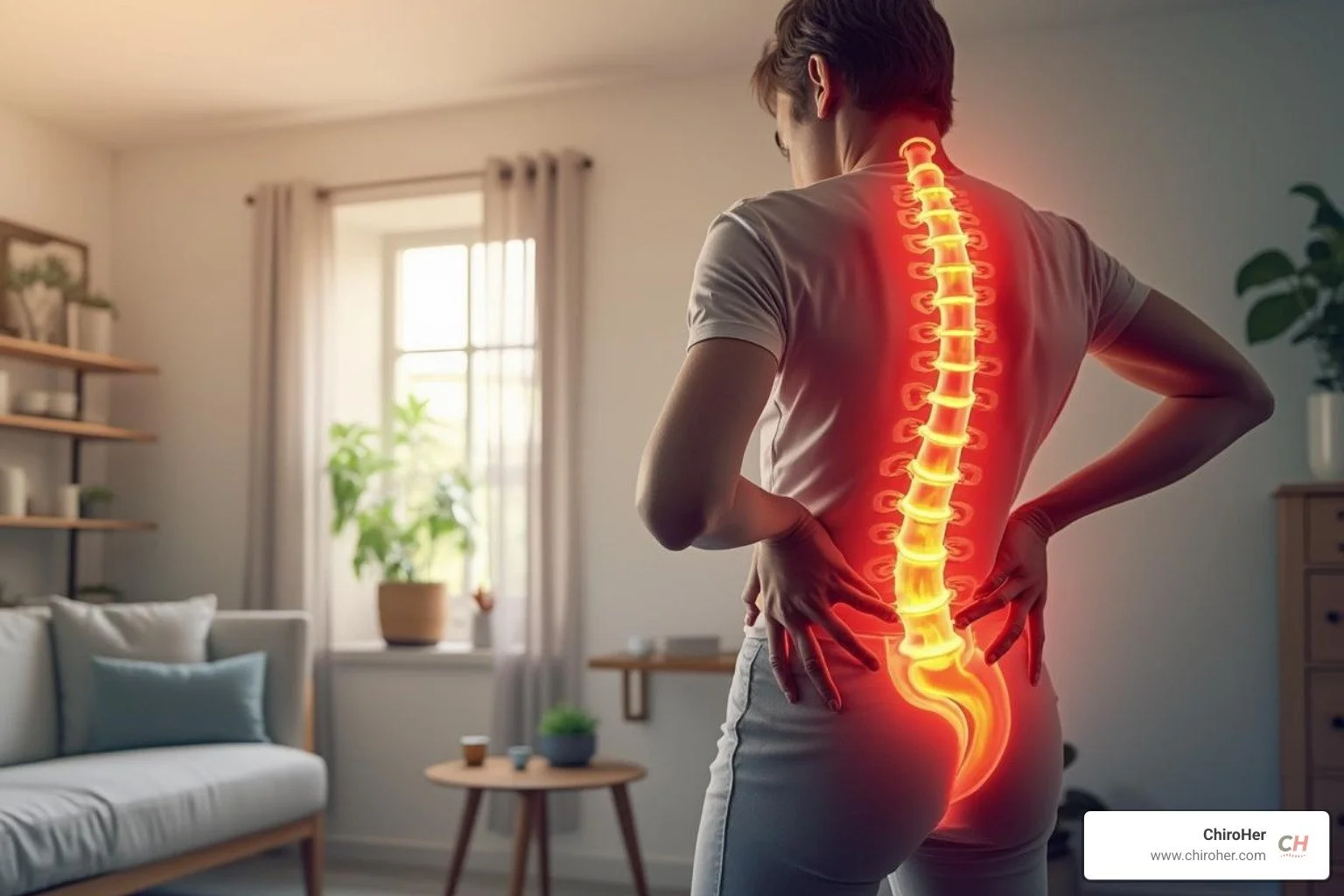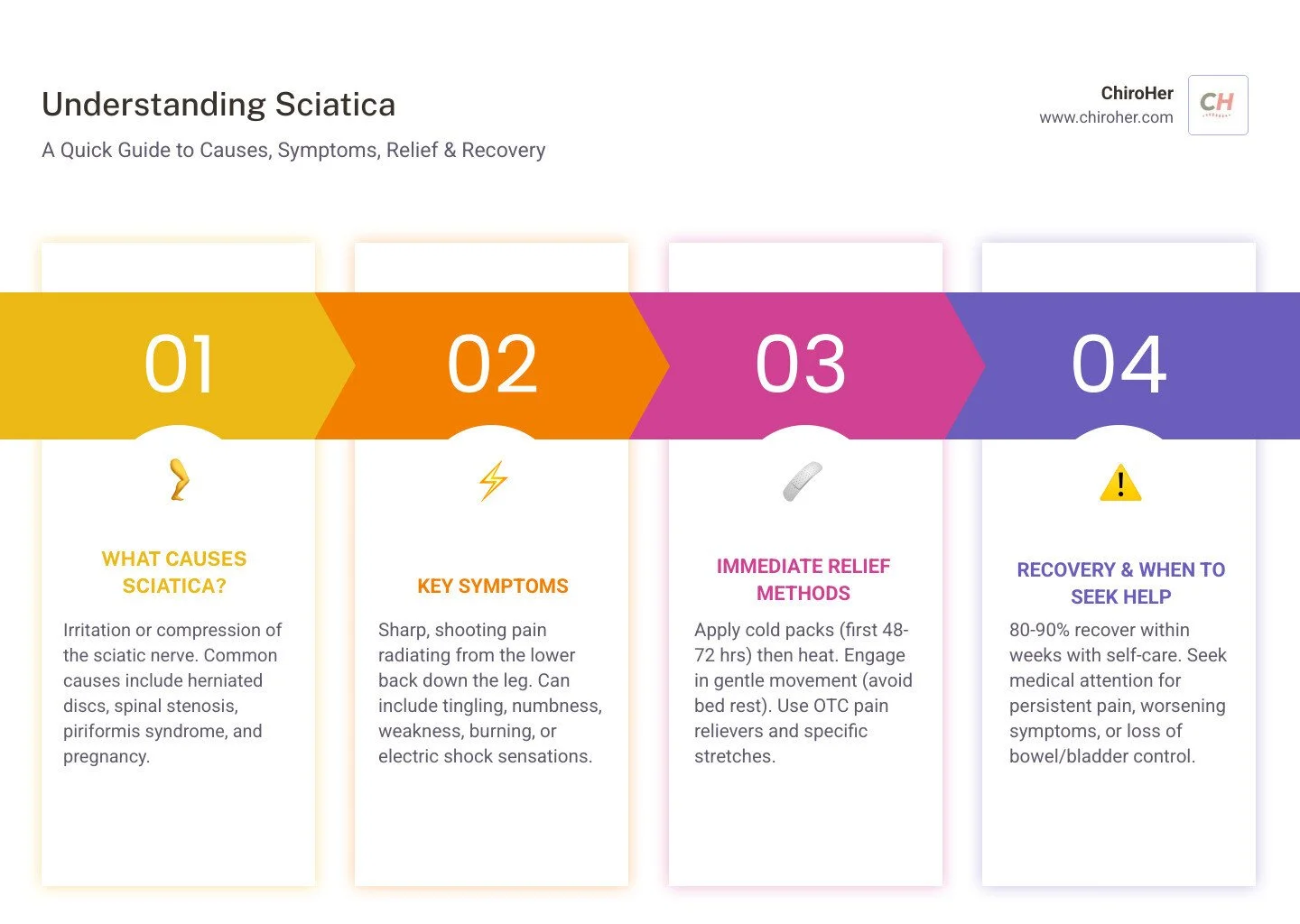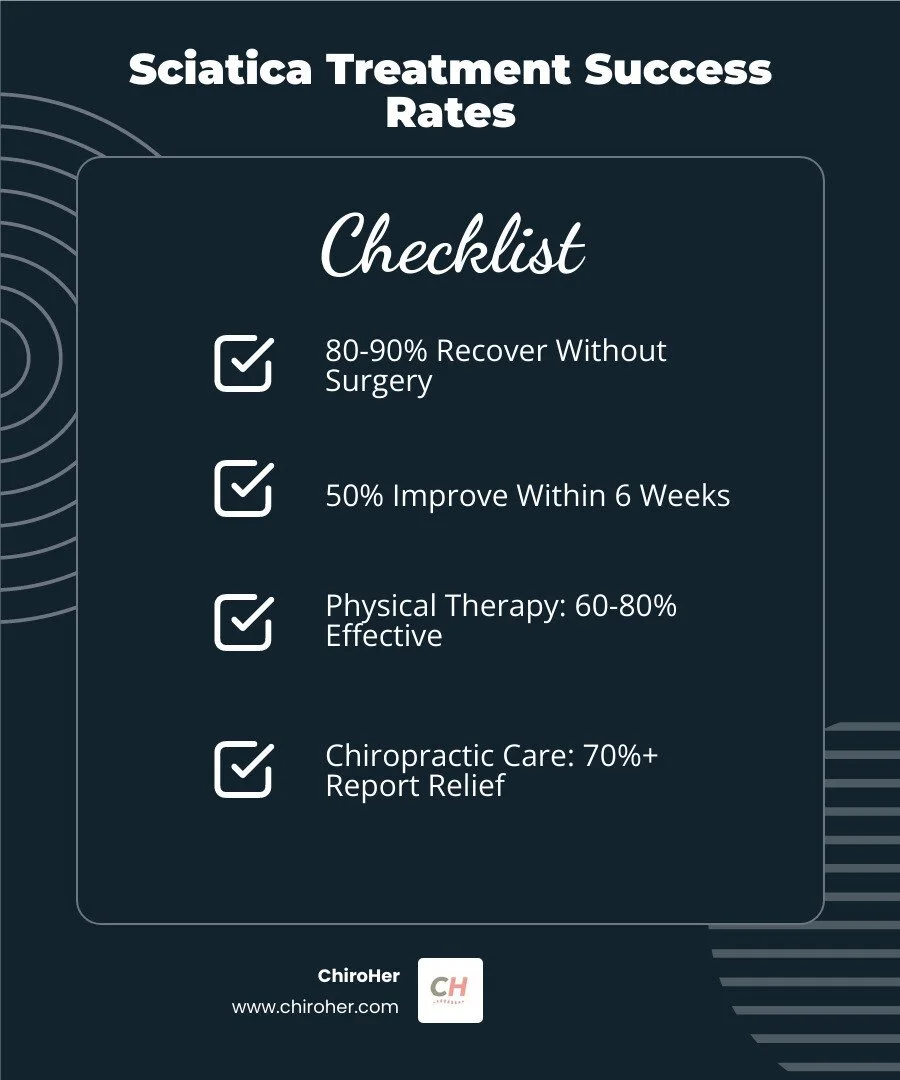How to Ease Sciatic Nerve Pain Without Losing Your Mind
Understanding Sciatica and Your Path to Relief
How to ease sciatic nerve pain is a concern that affects up to 40% of people at some point in their lives. This sharp, shooting pain that radiates from your lower back down through your leg can feel overwhelming, but the good news is that most cases resolve without surgery.
Quick Relief Methods for Sciatic Nerve Pain:
Cold therapy - Apply ice packs for 15-20 minutes during the first 48-72 hours
Heat therapy - Use heating pads or warm baths after initial inflammation subsides
Gentle movement - Avoid bed rest and keep moving with light activities
Over-the-counter pain relievers - NSAIDs like ibuprofen can reduce inflammation
Specific stretches - Knee-to-chest and piriformis stretches provide targeted relief
Proper posture - Maintain good alignment while sitting and standing
Sciatica occurs when your sciatic nerve - the longest nerve in your body - becomes irritated or compressed. This can happen due to herniated discs, spinal stenosis, or even pregnancy-related changes. While the pain can range from a dull ache to an electric shock sensation, research shows that 80-90% of people recover within a few weeks with proper self-care.
Hi! I'm Dr. Michelle Andrews, founder of ChiroHer in Oklahoma City, and I've helped countless women find relief from sciatic nerve pain through personalized chiropractic care and targeted therapeutic approaches. My Webster Technique certification and extensive prenatal training have given me deep insight into how to ease sciatic nerve pain effectively, especially for expecting mothers and busy professionals.
Immediate Relief: How to Ease Sciatic Nerve Pain at Home
When sciatica strikes, your first instinct might be to head straight to bed and wait it out. But here's what the research tells us: bed rest is not your friend. In fact, staying in bed for more than a couple of days can actually make your pain worse and slow your recovery.
The key to immediate relief lies in understanding that sciatica pain responds best to a combination of gentle movement, targeted temperature therapy, and appropriate pain management. About 90% of people with sciatica recover without surgery, and most see significant improvement within just a few weeks when they follow the right approach.
Gentle Movement and Activity to Ease Sciatic Nerve Pain
Movement is probably the most important thing you can do to help your sciatic nerve pain. While it might seem counterintuitive when you're hurting, gentle activity actually helps in several ways:
Why Movement Helps:
Strengthens the muscles that support your spine
Improves flexibility and range of motion
Boosts blood flow to injured areas, speeding healing
Reduces your perception of pain
Prevents the stiffness that comes with prolonged inactivity
Start with simple activities like walking around your house or gentle stretching. Even 10-15 minutes of movement every few hours can make a significant difference. The key is to listen to your body - if something increases your pain, stop and try something gentler.
Extended sitting is particularly problematic for sciatica. It increases pressure on your spine and can worsen nerve compression. If you work at a desk, set a timer to remind yourself to stand and move every 30 minutes.
Hot and Cold Therapy for Sciatica Pain
Temperature therapy is one of the most accessible and effective ways to manage sciatic nerve pain at home. The key is knowing when to use cold versus heat, and how to apply them safely.
Cold Therapy (First 48-72 Hours): Cold therapy works by reducing inflammation around the sciatic nerve. Here's how to do it effectively:
Apply ice packs wrapped in a thin towel for 15-20 minutes at a time
Take 15-20 minute breaks between applications
You can repeat this cycle for 75-100 minutes total
Never apply ice directly to your skin
Heat Therapy (After 72 Hours): Once initial inflammation subsides, heat therapy can help relax muscles and increase blood flow:
Use a heating pad on low setting for 15 minutes to 2 hours
Take warm baths or showers
Apply heat with a cloth barrier - never directly on skin
Ensure the heat feels warm, not hot
Never fall asleep with a heating pad
Many of our patients find alternating between cold and heat particularly effective once they're past the initial inflammatory phase.
Targeted Relief: Exercises and Stretches for Sciatica
Once you've managed the initial pain, the next step in learning how to ease sciatic nerve pain is through targeted exercises and stretches. Think of these movements as your personal toolkit for relief. They don't just help you feel better right now; they also work to prevent the pain from coming back.
The secret to success is picking the right movements and doing them correctly. Always remember to listen to your body. If any exercise makes your pain worse, please stop right away and check in with a healthcare professional.
Recommended Stretches to Ease Sciatic Nerve Pain
These stretches gently target the muscles and areas that often contribute to sciatic nerve compression. Healthline recommends these helpful stretches for sciatic pain relief.
The Glute Bridge is a fantastic way to start. You lie on your back with your knees bent and feet flat on the floor. Gently lift your hips until your body forms a straight line from your knees to your shoulders. Hold this for 5 to 30 seconds. This move strengthens your glutes and core, while also giving your hip flexors a nice stretch.
Next, try the Knee-to-Chest Stretch. Lie on your back and bring one knee toward your chest, holding it gently behind your thigh. Hold for 20-30 seconds, then switch to the other side. Many people find this stretch brings immediate comfort by easing tension in the lower back.
The Seated Piriformis Stretch is especially helpful if your piriformis muscle is contributing to your pain. Sit in a chair and cross your affected leg over the other, placing your ankle on your opposite knee. Lean forward gently until you feel a stretch in your buttock. Hold for 20-30 seconds.
Tight hamstrings can also play a role in lower back stress and sciatic nerve irritation. The Hamstring Stretch can help. Lie on your back and lift one leg, keeping it straight. You can use a towel or strap looped around your foot to help pull your leg gently toward you. Hold for 20-30 seconds, then switch legs.
For improving spinal movement and reducing stiffness, the Cat-Cow Stretch is wonderful. Start on your hands and knees. As you breathe in, arch your back and lift your head. As you breathe out, round your spine and tuck your chin. Repeat this smooth, flowing movement 10-15 times.
The Bird-Dog exercise is excellent for building core stability. From your hands and knees, slowly extend your opposite arm and leg at the same time. Hold for 5-30 seconds, then switch sides.
Consider the Cobra Stretch to help decompress your spine. Lie on your stomach and gently push up with your arms, keeping your hips on the ground. Hold for 30 seconds and repeat 4-5 times.
Finally, the Child's Pose Stretch offers gentle spinal decompression and can be very soothing. Kneel on the floor and sit back on your heels. Then, reach your arms forward and lower your chest toward the ground. You can hold this for 5 minutes or as long as it feels comfortable.
Strengthening Exercises for Long-Term Comfort
While stretches offer immediate relief, strengthening exercises are vital for long-term comfort and preventing sciatica from returning. Focusing on your core, glutes, and hamstrings will support your spine and pelvis, reducing pressure on that sensitive sciatic nerve.
Your core muscles act like a natural, internal back brace. A strong core supports your spine and takes pressure off the sciatic nerve. You can start with gentle moves like modified planks or "dead bugs," slowly building up your strength over time.
Weak glute muscles are a surprisingly common reason for sciatic pain. Exercises like glute bridges, clamshells, and side-lying leg lifts can really help. Strong glutes help keep your pelvis aligned correctly, easing stress on your lower back.
Having balanced strength between your hamstrings and quadriceps is also important for spinal health. Gentle hamstring curls and bridges can help build this strength without bothering your sciatic nerve.
At ChiroHer, we believe in empowering you with the tools for lasting relief. That's why we often include therapeutic exercises as part of our personalized treatment plans.
Professional Help: When to Seek Medical Attention
While most sciatica cases improve with home care, there are times when professional help becomes necessary. I've seen patients who waited too long to seek treatment, and unfortunately, delayed care can sometimes lead to complications that could have been prevented.
Loss of bowel or bladder control is a medical emergency that requires immediate attention. This can indicate a serious condition called cauda equina syndrome, which needs urgent treatment to prevent permanent nerve damage.
Other red flags include severe weakness in your legs, especially if it's getting worse, numbness around your genitals or buttocks, and fever accompanying your back pain. If you experience any of these symptoms, don't wait - seek medical care immediately.
For less urgent situations, consider seeing a healthcare provider if your pain hasn't improved after a few weeks of home treatment, if symptoms are getting worse despite self-care, or if you're experiencing moderate numbness or tingling. Research shows that if you haven't found any relief from the symptoms of sciatica through conservative treatments, your pain lasts longer than six weeks, or you experience numbness and tingling, you should see a doctor.
Medical Treatments for Sciatica
When home remedies aren't providing enough relief, several medical treatments can help you find comfort and healing. The approach depends on your specific symptoms, how long you've been dealing with pain, and what's causing your sciatica.
Prescription medications often provide more targeted relief than over-the-counter options. Muscle relaxers can help reduce the muscle spasms that often accompany nerve compression, while stronger anti-inflammatory medications may be more effective than ibuprofen alone. For nerve-specific pain, medications like gabapentin can be particularly helpful.
Physical therapy addresses the root causes of your sciatica by strengthening supporting muscles and improving your movement patterns. A good physical therapist will design a program specifically for your condition and teach you exercises to prevent future episodes.
Chiropractic care focuses on restoring proper spinal alignment and function. At ChiroHer, we use gentle, evidence-based techniques that are particularly effective for women and prenatal patients. Our approach combines spinal adjustments with manual therapy techniques to improve joint mobility and reduce muscle tension.
For patients who need additional support, we often incorporate electric muscle stimulation to help reduce pain and muscle spasms while promoting healing.
When conservative treatments haven't provided sufficient relief, injection therapies may be recommended. Epidural steroid injections can provide relief for up to three months by reducing inflammation around the affected nerve.
Surgery is rarely necessary for sciatica - only about 10% of patients require surgical intervention. Common procedures include microdiscectomy to remove part of a herniated disc and laminectomy to create more space for the nerve.
Complementary Therapies for Sciatica Pain
Several complementary therapies have shown remarkable promise in treating sciatic nerve pain, often providing relief when traditional approaches haven't been fully effective.
Acupuncture has gained significant scientific support for sciatica treatment. One focus study group found acupuncture more effective at treating sciatica than some medications. At ChiroHer, we offer acupuncture as part of our comprehensive approach to pain management.
Massage therapy offers both physical and emotional benefits for sciatica sufferers. Massage increases circulation, decreases stress and relaxes muscles, which can ease sciatic pain. Therapeutic massage helps reduce muscle tension and improve blood flow to affected areas.
Yoga can be incredibly beneficial, especially gentle forms like Iyengar yoga that emphasize proper alignment. Regular yoga practice improves flexibility, strengthens supporting muscles, and reduces stress.
Mind-body techniques like meditation, deep breathing exercises, and relaxation techniques can help manage the stress and anxiety that often accompany chronic pain conditions.
The key to successful treatment is finding the right combination of approaches for your specific situation. At ChiroHer, we work with each patient to develop a personalized treatment plan that addresses not just your symptoms, but the underlying causes of your sciatica.
Long-Term Management: Preventing Sciatica Recurrence
Once you've experienced sciatic nerve pain, you know how much you want to avoid it ever coming back! The good news is that preventing sciatica recurrence is absolutely within your reach. By adopting a few smart prevention strategies and making thoughtful lifestyle changes, you can significantly reduce your chances of future flare-ups.
Maintain Good Posture
Good posture is like a secret superpower for your spine. When your posture is off, it can put extra strain on your back and even pinch that sensitive sciatic nerve. To keep your spine happy and help how to ease sciatic nerve pain long-term, try to be mindful of your posture throughout the day. This means always striving to keep your shoulders back and down, maintain the natural curves of your spine, and use ergonomic furniture at your desk. Remember to take regular breaks from sitting or standing for too long, and ensure you're sleeping with proper spinal alignment using supportive pillows. The Cleveland Clinic offers some fantastic insights on why maintaining good posture is so vital for your health.
Stay Active and Exercise Regularly
Consistent physical activity is one of the very best ways to prevent sciatica from returning. Regular movement keeps your muscles strong and flexible, which in turn supports your spine. Aim to include a mix of activities in your routine. Aerobic exercise like walking, swimming, or cycling is great for overall health and circulation. Don't forget to include core strengthening exercises to build that natural back brace, and make time for flexibility and stretching routines.
Maintain a Healthy Weight
Carrying extra weight puts unnecessary stress on your spine. This added pressure can increase your risk of disc problems and sciatic nerve irritation. Even a modest weight loss can make a significant difference in reducing that strain on your lower back and sciatic nerve.
Practice Safe Lifting Techniques
Improper lifting is a super common cause of back injuries and sciatic nerve pain. To protect yourself, always remember to bend at your knees, not your waist, and keep the object close to your body. It's also crucial to avoid twisting while lifting. If something feels too heavy or awkward, don't be a hero - get help or use proper lifting equipment.
Quit Smoking
Smoking can actually hurt your spinal health. The chemicals in tobacco can reduce blood flow to your spinal discs, making them more prone to injury and slower to heal if damage occurs. If you're looking for another great reason to quit, protecting your spine and preventing sciatica recurrence is a powerful motivator.
Manage Stress
Chronic stress often leads to muscle tension, especially in your back and shoulders. This tension can contribute to pain and even make sciatica worse. Finding ways to manage stress is incredibly beneficial for your overall well-being and for preventing back issues. Try incorporating regular relaxation practices, ensuring you get adequate sleep, exploring mindfulness or meditation, and making time for hobbies and activities you enjoy.
Create an Ergonomic Environment
Whether you spend your days at an office desk or tackling tasks at home, your environment plays a big role in your spinal health. Setting up your space ergonomically can prevent unnecessary strain. Make sure you use a supportive chair with proper lumbar support, position your computer screen at eye level, and keep frequently used items within easy reach.
Build and Maintain Core Strength
Think of your core muscles as your body's natural back brace. A strong core provides incredible support for your spine. This support helps reduce the risk of injury and keeps your spine stable, which is absolutely necessary for preventing sciatica. Regularly working on these muscles is a cornerstone of long-term spinal health.
At ChiroHer, we truly believe in empowering our patients. We love working with you to develop personalized prevention strategies that fit seamlessly into your unique lifestyle. This custom approach is especially important for women, who may have unique considerations related to pregnancy, hormonal changes, and different movement patterns.
Frequently Asked Questions about Sciatica
How long does sciatica usually last?
If you're dealing with sciatic nerve pain right now, you're probably wondering when this discomfort will finally end. The good news is that most people see significant improvement much sooner than they expect.
Research consistently shows that 80-90% of people with sciatica recover without surgery, and about half experience meaningful relief within six weeks. Most cases resolve completely within 4-6 weeks when you follow appropriate self-care strategies and treatment recommendations.
Your recovery timeline depends on several factors. The underlying cause plays a big role - a simple muscle strain might resolve in days, while a herniated disc could take several weeks. Your age, overall health, and how quickly you start appropriate treatment all influence your healing process.
The most important thing to remember is that staying active and not waiting too long to seek professional help can significantly speed your recovery. At ChiroHer, we've seen patients who address their symptoms early often recover much faster than those who try to "tough it out" for months.
Can sciatica affect both legs?
While sciatica typically affects one leg at a time, it can occasionally involve both legs simultaneously. This happens less frequently, but when it does, it may signal a more serious underlying condition that needs immediate attention.
Bilateral sciatica (affecting both legs) can indicate severe spinal stenosis, where the spinal canal becomes significantly narrowed. It might also suggest bilateral disc herniation, spinal tumors, or infections affecting the spine.
The most concerning condition associated with bilateral sciatica is cauda equina syndrome, which is a medical emergency. This occurs when the nerve roots at the bottom of your spinal cord become severely compressed. If you experience sciatica symptoms in both legs, especially when accompanied by bowel or bladder problems, numbness around your genitals, or severe weakness, seek immediate medical attention.
Most of the time, sciatica affects just one side because the nerve compression typically occurs on one side of your spine. If you're experiencing symptoms on both sides, don't panic, but do get evaluated promptly by a healthcare professional.
Is surgery always necessary for sciatica?
One of the most common concerns I hear from patients is whether they'll need surgery for their sciatic nerve pain. Let me put your mind at ease: surgery is rarely necessary for sciatica.
Only about 10% of people with sciatica require surgical intervention. The vast majority find relief through conservative treatments like the ones we use at ChiroHer - chiropractic care, physical therapy, exercises, and lifestyle modifications.
Surgery is typically considered only in specific situations. You might need surgical evaluation if conservative treatments have failed after several months, if you're experiencing severe and progressive weakness in your legs, or if you have loss of bowel or bladder control. Cauda equina syndrome, which I mentioned earlier, is another indication for emergency surgery.
The most common surgical procedures for sciatica include microdiscectomy (removing part of a herniated disc) and laminectomy (creating more space for the nerve). While these procedures can be effective when truly needed, they're not the first line of treatment.
At ChiroHer, we've helped many patients avoid surgery through comprehensive, personalized treatment approaches. Our focus on addressing the root causes of sciatic nerve pain, combined with patient education about how to ease sciatic nerve pain naturally, has helped countless women return to their active lives without surgical intervention.
Regain Your Comfort and Mobility
Feeling that sharp, shooting sciatic nerve pain can truly stop you in your tracks. But here's the good news: it doesn't have to control your life! With the right steps, you can find how to ease sciatic nerve pain and get back to doing what you love. By combining immediate relief strategies, gentle exercises, and getting professional help when you need it, comfort and freedom of movement can be yours again.
Getting back to feeling good takes time, and that's perfectly okay. Some days might feel better than others, and that's a normal part of healing. The most important thing is to keep up with your self-care, truly listen to what your body is telling you, and reach out for help when you need an extra hand.
Here at ChiroHer, we truly get it. We know the unique challenges that women face when dealing with sciatic nerve pain. Maybe it's pregnancy-related sciatica, everyday stress from work, or changes that come with age. Whatever the reason, our team is ready to offer the personalized, caring support you deserve.
Our approach is all about you. We bring together proven chiropractic methods with comforting therapies like acupuncture and helpful exercises. We're proud to serve women across Oklahoma City, Yukon, Edmond, Nichols Hills, Del City, Mustang, and Moore. You'll find the specialized care you need in a calm, welcoming space.
You don't have to let sciatic nerve pain hold you back from living your best life. Why not take that first step towards feeling better? You can learn more about how we help with low back sciatic pain on our website. Ready to get started? It's easy! Just schedule a consultation with our friendly team today, or simply book now to start your path to feeling like yourself again.
Your comfort and being able to move freely truly matter. We'd love to help you get both back.







